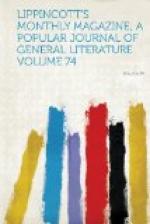The United States government took particular interest in this exposition, and published a long and detailed report made by its commissioners. Our contributions were not worthy of the country, and showed but little novelty. Implements of farming and of war, pianos, sewing-machines and locomotives attracted chief attention. The pianos were “unreservedly praised.” The wines, California having come to the rescue, were pronounced an improvement on previous specimens. The only trait of our engines that was admired or borrowed appears to have been that which had least to do with the organism of the machine—the cab. In cars our ideas have fruited better, and Pullman and Westinghouse have gained a firm foothold in England, with whose endorsement their way is open across the Channel. In the arts we are credited with seventy-five pictures, against a hundred and twenty-three from England and six hundred and fifty-two from France.
[Illustration: PARIS EXPOSITION BUILDING AND GROUNDS, 1867.]
Here France was at home, and felt it. The works of Dubray, Triquetti, Yvon, Giraud, Gerome, Dubufe, Toulmouche, Courbet, Troyon, Rosa Bonheur and others exhibited the route toward the naturalistic taken by her modern school, so different from that pursued by the Pre-Raphaelites in England. The Duesseldorf school has been drawn into the same path—France’s one conquest from Prussia, who made at the same time a stout struggle in defence of the classic manner through Kaulbach. The drawings and paintings of art-students maintained by the French government in Italy attested an enlightened liberality other governments, general or local, would do well to imitate. The cost of supporting a few score of pupils in Rome could in no way be better bestowed for the promotion of commerce, manufactures and education. Taste has unquestionably a high economic value. But this is only one of France’s ways of recognizing the fact. The government Ecole des Beaux Arts at Paris contained, in 1875, a hundred and seventy-two students of architecture, a hundred and eighty-three of painting, forty of sculpture and two hundred and fifty of engraving.




